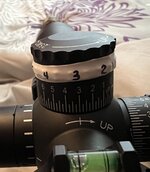justin davis
WKR
I like to range and dial for most shots. I use 2nd focal plane scope.
Got this trick from Ryan Avery, but I just use white electrical tape and wrap a small piece on the turret and write in the dope for the general conditions we will be hunting in. (100-900). Then all you do is range quick and dial real quick.
Similar to what I do with a bow. I range and then dial the bow. I’m a range finding whore and use it all the time.
Typically when walking around we just move the turret and set it to 200 yards. So if anything is close it’s just shoot. But if it’s way out there then can dial.
Here is a pic. 3 is 300 4 is 400 etc
I hardly rifle hunt (only for coyotes). My wife does the rifle hunting. So while it might be quicker to do a holdover. The dial and aim right on is easier and simplified for my wife
Got this trick from Ryan Avery, but I just use white electrical tape and wrap a small piece on the turret and write in the dope for the general conditions we will be hunting in. (100-900). Then all you do is range quick and dial real quick.
Similar to what I do with a bow. I range and then dial the bow. I’m a range finding whore and use it all the time.
Typically when walking around we just move the turret and set it to 200 yards. So if anything is close it’s just shoot. But if it’s way out there then can dial.
Here is a pic. 3 is 300 4 is 400 etc
I hardly rifle hunt (only for coyotes). My wife does the rifle hunting. So while it might be quicker to do a holdover. The dial and aim right on is easier and simplified for my wife
Attachments
Last edited:

